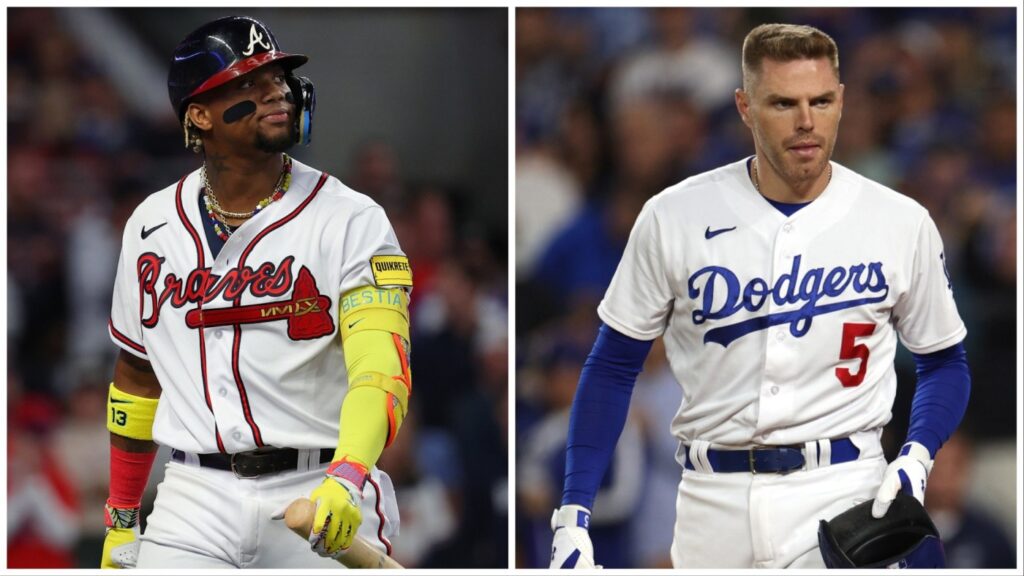
Ronald Acuña Jr. collected his first hit of the postseason in Game 3 of the Atlanta Braves’ National League Division Series against the Philadelphia Phillies on Wednesday. The first two hitters in Atlanta’s lineup were an underwhelming 2 for 13, with two walks and six strikeouts, between Games 1 and 2.
In spite of this, the sky did not fall somewhere over Cobb County. An Austin Riley home run and an all-time great game-ending double play lifted the Braves to a series-tying victory in Game 2, restoring their chances to win the best-of-five series.
Still, many of the forces that threatened the 104-win Braves and the 100-win Dodgers in their respective division series were one and the same: After not playing for five days, their biggest stars suddenly were not hitting like stars.
As Mookie Betts and Freddie Freeman – the Dodgers’ first two hitters – flew to Phoenix sitting on a combined 1 for 13 batting line Tuesday, the context for their struggles was impossible to ignore. In the American League, the Baltimore Orioles’ first two hitters were a combined 2 for 15 in Games 1 and 2 before their series shifted to Arlington, Texas, where they were promptly swept by the Rangers.
This year and last, the Houston Astros are the exception to the rule. Their first two hitters were a combined 4 for 14 with one walk in Games 1 and 2 of their series with the Minnesota Twins. Houston was the only team with a first-round bye in either league to advance to the World Series last year, so perhaps the secret sauce eluding the other top-two seeds remains a closely guarded secret in the front offices of Minute Maid Park. Where’s a good whistleblower when you need one?
When the best regular-season teams mystically transform into the worst postseason teams, the cognitive dissonance for fans can be overwhelming. A simple, convincing explanation is needed.
The layoff can’t be hurting pitchers, right? Teams who skip straight to the division series can line up their best pitchers to pitch the most innings. All their relievers are fully rested. So “the long layoff is really hard on hitters, especially those who bat at the top of the lineup” makes intuitive sense. The numbers back it up too.
Until you look at 2022.
Last year, the Braves’ top two hitters were a combined 5 for 15 (.333) through the first two NLDS games en route to a four-game loss against the Phillies. The 2022 Dodgers’ top two went 4 for 17 with two home runs in their first two NLDS games against the San Diego Padres.
Ironically, last year’s top two AL seeds – the Astros (3 for 16) and New York Yankees (2 for 15) – got very little production from the top of their lineups in Games 1 and 2 of their respective series. Both teams went on to meet in the next round.
So, what changed when the wild-card round expanded from a single play-in game to a best-of-three format?
Not much, the numbers show. From 2012 to 2019 – the first eight seasons under the one-game wild-card format, the quality of pitching in the division series compared to the regular season was obvious. League-wide, on-base plus slugging percentage plunged once the regular season ended.
In 2012, the league-wide OPS was .724 in the regular season and .643 in the division series round, an 11.2% decrease. From 2013-19, hitters did only a slightly better job of adapting. The drop in OPS ranged from 4.0% to 9.4%.
The 2020 postseason format was different altogether, then reverted to the previous format in 2021 (when OPS fell by 5.8% from the regular season to the division series round). If half the teams’ hitters were negatively affected by a longer layoff in 2022, we would expect to see that reflected somewhere in the division series batting lines. But we don’t.
Instead, we see a 6.3% drop in OPS from the regular series to the division series round – perfectly in line with where we left off in 2021.
The better question is, what changed from last year to this year?
Through Tuesday, there had been 768 plate appearances in the division series round. Three of the four series were still in progress, but that’s roughly a full season’s worth of plate appearances for one player in a 162-game season. In other words, it’s not nothing.
And, lo and behold, hitters had actually improved their OPS in the division series (.750) compared to the regular season (.734).
Any rhyme or reason to it is dwarfed by the overwhelming randomness of baseball itself. Dodgers third baseman Max Muncy was asked if he would prefer to not have the five days off after the regular season and participate in the wild-card round instead. He took a stab at an answer.
“I don’t know what it’s like on the other side, so I can’t really answer that question fairly,” Muncy said. “I could say that, yeah, we’d rather be playing right away or not. But the reality is if you have the days off, you’re one of the top seeds and you have home-field advantage. And really when you think about it that’s the most important thing. But I can’t give you a fair answer because we haven’t done the other side.”
The takeaway: we all need a few more years under this postseason format to separate the signal from the noise.
